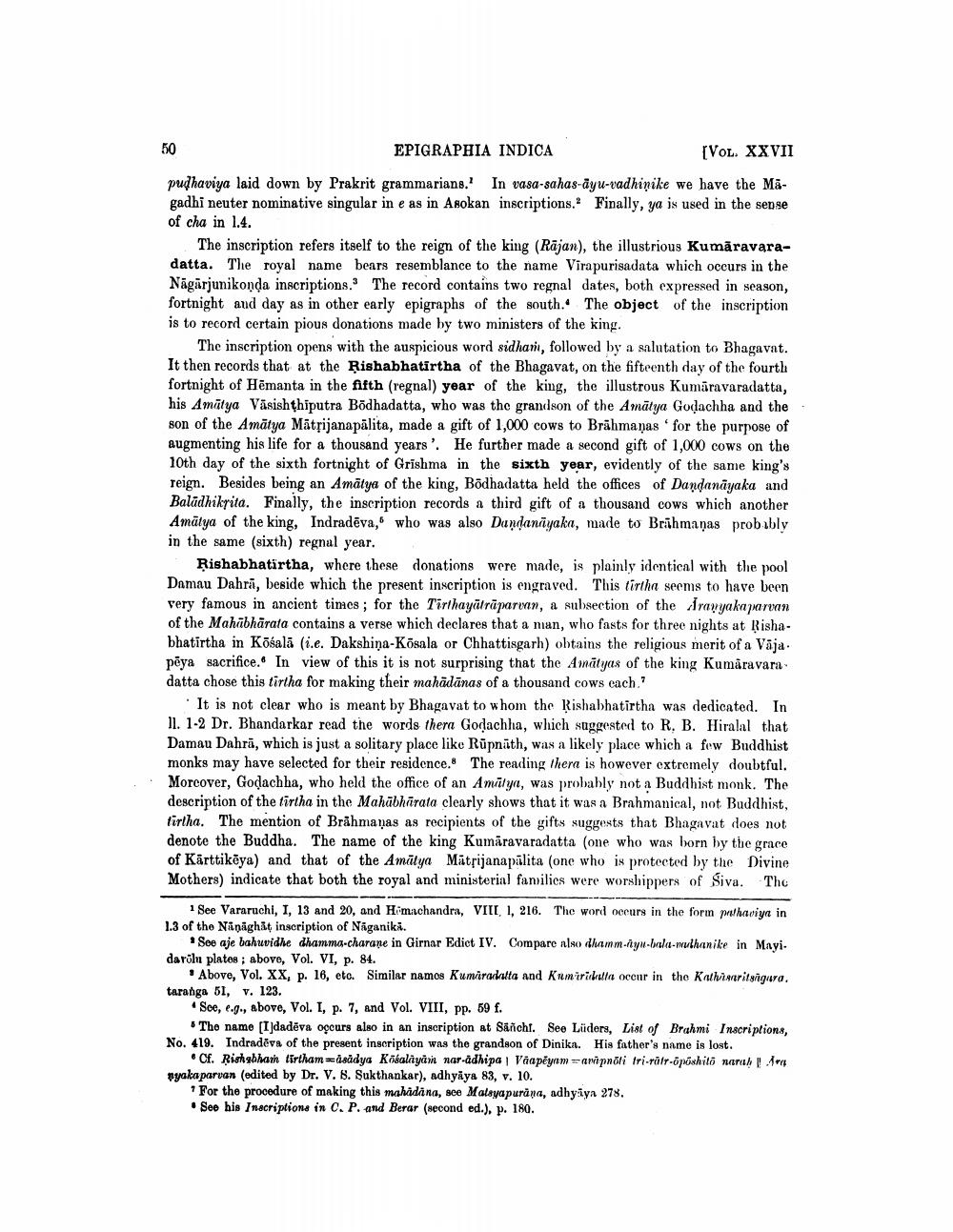________________
EPIGRAPHIA INDICA
[VOL. XXVII
pudhaviya laid down by Prakrit grammarians. In vasa-sahas-dyu-vadhinike we have the Mägadhi neuter nominative singular in e as in Asokan inscriptions. Finally, ya is used in the sepse of cha in 1.4.
The inscription refers itself to the reign of the king (Rājan), the illustrious Kumāravaradatta. The royal name bears resemblance to the name Virapurisadata which occurs in the Nagarjunikonda inscriptions. The record contains two regnal dates, both expressed in season, fortnight and day as in other early epigraphs of the south. The object of the inscription is to record certain pious donations made by two ministers of the king.
The inscription opens with the auspicious word sidhari, followed by a salutation to Bhagavat. It then records that at the Rishabhatirtha of the Bhagavat, on the fifteenth day of the fourth fortnight of Hēmanta in the fifth (regnal) year of the king, the illustrous Kumāravaradatta, his Amūtya Võsishthiputra Bödhadatta, who was the grandson of the Amātya Godachha and the son of the Amātya Mātrijanapalita, made a gift of 1,000 cows to Brāhmaṇas for the purpose of augmenting his life for a thousand years'. He further made a second gift of 1,000 cows on the 10th day of the sixth fortnight of Grishma in the sixth year, evidently of the same king's reign. Besides being an Amatya of the king, Bödhadatta held the offices of Dandanayaka and Balādhikrita. Finally, the inscription records a third gift of a thousand cows which another Amātya of the king, Indradēva, who was also Dandanayaka, made to Brāhmaṇas probably in the same (sixth) regnal year.
ķishabhatirtha, where these donations were made, is plainly identical with the pool Damau Dahrā, beside which the present inscription is engraved. This tirtha seems to have been very famous in ancient tines; for the Tirthayātrāparuin, a subsection of the Arawyakaparuan of the Mahābhārata contains a verse which declares that a man, who fasts for three nights at Rishabhatirtha in Kõsalā (ie. Dakshina-Kösala or Chhattisgarh) obtains the religious merit of a Vāja. pēya sacrifice. In view of this it is not surprising that the Amatyas of the king Kumāravara datta chose this tirtha for making their mahādānas of a thousand cows cach.'
It is not clear who is meant by Bhagavat to whom the Rishabhatirtha was dedicated. In 11. 1-2 Dr. Bhandarkar read the words thera Godachha, which suggested to R. B. Hiralal that Damau Dahrā, which is just a solitary place like Rūpnāth, was a likely place which a few Buddhist monks may have selected for their residence. The reading there is however extremely doubtful. Moreover, Godachha, who held the office of an Amatya, was probably not a Buddhist monk. The description of the tirtha in the Mahabharata clearly shows that it was a Brahmanical, not Buddhist. tirtha. The mention of Brāhmaṇas as recipients of the gifts suggests that Bhagavat does not denote the Buddha. The name of the king Kumāravaradatta (one who was born by the grace of Kärttikėya) and that of the Amatya Mātrijanapalita (one who is protected by the Divine Mothers) indicate that both the royal and ministerial fanilies were worshippers of Siva. The
1 See Vararuchi, I, 13 and 20, and Himachandra, VIII1, 216. The word occurs in the form prhaviyn in 1.3 of the Nänäghät inscription of Naganiki.
See aje bahuvidhe dhamma charane in Girnar Edict IV. Compare also dhamm-ryw-bala-nulhanike in Mayi. darõlu plates ; above, Vol. VI, p. 84.
Above, Vol. XX, p. 16, etc. Similar namos kumaradatta and Kumiribulla occur in the Kathisaritsngura. taranga 51, v. 123.
Soe, e.g., above, Vol. I, p. 7, and Vol. VIII, pp. 59 f.
The name 'Idadēva opcurs also in an inscription at Sáncht. See Lüders, List of Brahmi Inscriptions, No. 419. Indradēva of the present inscription was the grandson of Dinika. His father's name is lost.
Cf. Rishabhanh tirtham såsädya Köéalāyām naradhipa | Vaapeynim =anipnoli Iri-tilt-õpāshilo naruh. wyaka parvan (edited by Dr. V. 8. Sukthankar), adhyāya 83, v. 10.
For the procedure of making this mahadana, see Malayapurana, adhyaya 278. Seo his Inscriptions in C. P. and Berar (second ed.), p. 180.




